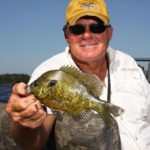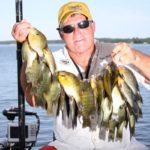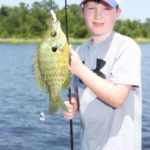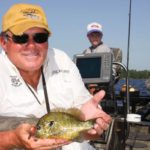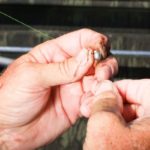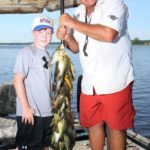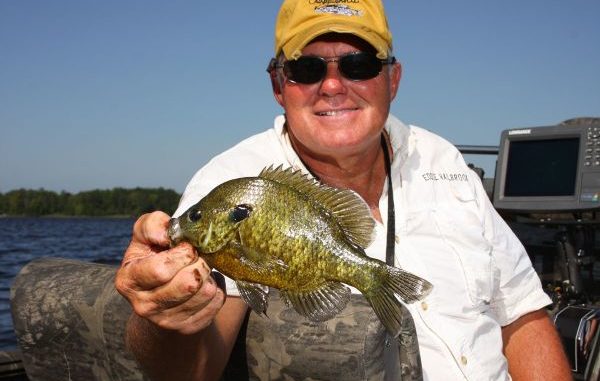
Chinqapin aren’t the biggest fish in Grand Bayou, and that’s probably a good thing. Otherwise, when they exploded on a worm you wouldn’t be able to hold the rod.
As far as clichés go, few are more frequently used than, “Dynamite comes in small packages.”
However, behind every cliché, there is some truth, and in the case of this overused proverb, the truth is that one small thing can affect many things in a big way.
Take chinquapin, for instance.
They look a lot more like a firecracker than a stick of dynamite.
But, boy, when you hook into one — boom. The fight is on.
I\’ve heard it said that if a chinquapin were as big as a bass, nobody would ever be able to reel one in.
I\’m not too sure how true that is, but there is no denying that chinquapin, aka redear sunfish and shellcrackers, are small things that can affect many things in a big way.
My love affair with chinquapin began several years ago when Caney Lake fishing guide Eddie Halbrook invited me to catch some that were spawning in the back of Hancock Creek.
I still have a print of one of those fish that went 13 inches on Halbrook\’s Golden Rule.
A few years have passed since that trip, though, and the best I can recall we caught those spawning chinquapin during late April.
That’s why I was a little surprised when Halbrook called me to see if I wanted to go chase some spawning chinquapin during August. Only this time, we would be fishing Grand Bayou rather than Caney Lake.
My son and I were just wrapping up another fishing trip in Jonesville and ready to head home when we got the invitation — Grand Bayou was in the total opposite direction.
But remembering the fun I had with Halbrook all those years ago at Caney Lake, I decided it wouldn’t be too much of a problem to head northwest to Coushatta rather than southeast to Franklinton.
“These fish at Grand Bayou will move up again to spawn around the August full moon,” Halbrook told me as we launched his boat at the Grand Bayou Resort boat ramp just off state Highway 784. “But we\’re not going to be fishing for them like we did at Caney.
“We\’re using worms, but I drop-shot these fish rather than fish under a cork.”
Really? Drop-shotting chinquapin? Did he just say that?
I thought a drop-shot was a specialized finesse rig for pressured bass that was making inroads into saltwater through anglers looking for something better than a Carolina rig.
Thankfully, as Halbrook idled into the first spot he wanted to try, he also revealed to me that a drop-shot was one of the two different rigs we would be trying.
“These redears, or chinquapin bream, are going to be in water anywhere from 6 to 8 feet deep,” he explained, “and I’ll be catching them two different ways: We’ll be drop-shooting for them, and I’ll also be just tight-lining them.”
Halbrook dropped his anchor and started rigging some poles with his bream version of a drop-shot.
After threading some line through the eye of a No. 4 hook, he explained why he uses such a relatively long hook for bream fishing.
“The reason I’m using a No. 4 is because I can get a lot more of that cold worm on it,” he pointed out. “And it seems like the more cold worm I can put on it the better the fish bite it.”
He tied his main line to the hook with a regular Trilene knot, but he left the tag end a lot longer than normal.
To the end of this tag line, Halbrook clamped on two No. 5 split-shot weights just above a small knot he had already tied to keep the weights from sliding off as badly.
“I try to keep my drop line just under a foot,” he continued as he showed off the completed rig. “The reason I like to drop-shot these are that they\’re bottom feeders, and the closer to the bottom we can get the better they’ll bite.”
One of the reasons Halbrook uses split-shot weights is so he can simply shorten his drop line by sliding the weights up until he gets his worm close enough to the bottom for the fish to start biting.
He typically uses only one split-shot on his drop line if there is no wind, but Halbrook clamped on two because the wind was a little bit stronger than what he had expected before we left the ramp.
“Two will give us a little bit better feel when they hit it,” he noted.
We began fishing our drop-shot cold worms on a 6-foot flat just out from a pocket on the dam end of Grand Bayou Reservoir.
All three of us fished our drop-shots with spinning rods and reels, and that meant we only had three baits in the water.
Like a crappie angler who figures that eight poles are better than one, Halbrook decided we could maximize our time on the water by rigging up some jig poles with tight-lined cold worms and sticking them in some rod holders.
“What we’ve got here are Little Jewel poles — 8-foot, 10-foot poles — and we’ll just throw them out while we’re fishing and put them in the holders or just lay them down,” he said. “These tips are so sensitive that you’ll see the fish hit them.”
As I soon learned, Halbrook doesn’t give an area very long before he decides to pack up and move to a new spot. In fact, we hardly fished our first spot five minutes before he called all poles in.
“It ain’t rocket science,” he quipped. “If chinquapin are there they\’re going to eat these cold worms. It\’s not like you can sit on a spot until they move in. Rather, you’ve got to move to new spots until you find them.”
We bounced around to four or five more spots two boat lengths at a time before finally getting on top of a big school of chinquapin moving up to spawn.
For the next 30 minutes, we caught several big male chinquapin sitting in about 8 feet of water.
A few females that were obviously full of eggs confirmed the fish were preparing to spawn.
But for some reason, our drop-shot and tight-line bite suddenly shut down.
“I got another way I like to fish these chinquapin when the bite slows,” Halbrook said. “This lake has some good grass in it, and I think the fish move to that grass and hold tight sometimes.
“When that happens, I like to cast out a piece of cold worm and just drag it on the bottom.”
When he feels the weight above his hook pull into a patch of grass, Halbrook just lets it sit there a minute to entice fish he knows are holding close to the grass.
While staying in 8 feet of water, we started casting up to the edge of a 3-foot point where it dropped off into deeper water.
On some casts, the fish bit almost as soon as our baits hit the water. Other times, we had to soak our cold worms beside the grass.
Either way, Halbrook’s cast-and-drag technique extended the action for another hour or so, and we even pulled in a few nice-sized catfish that couldn\’t resist our cold worms.
Had we been just a few days later, Halbrook said we might have abandoned the drop-shot rigs for corks.
“You can fish the drop-shot as long as they are staging to spawn,” Halbrook explained. “But as soon as they move on the beds, I go strictly to a cork because I\’m fishing them in a lot shallower water.”
Whether you drop-shot or tight-line them on the flats as they stage to spawn or wait to cork them right on top of the spawning beds, you’re going to discover why Halbrook has such enthusiasm for chinquapin and why it has rubbed off on me in a big way.
“Each one might not be very big,” he said as he hauled our stringer full of fish out of his livewell, “but, man, look at these things. Kind of like a firecracker.
“One by itself may not be all that exciting, but when you tie four of five together — man, you’ve really got something then.”
Editor’s note: Contact Fishing Adventures with Eddie Halbrook at 318-548-1375.
